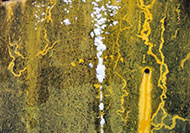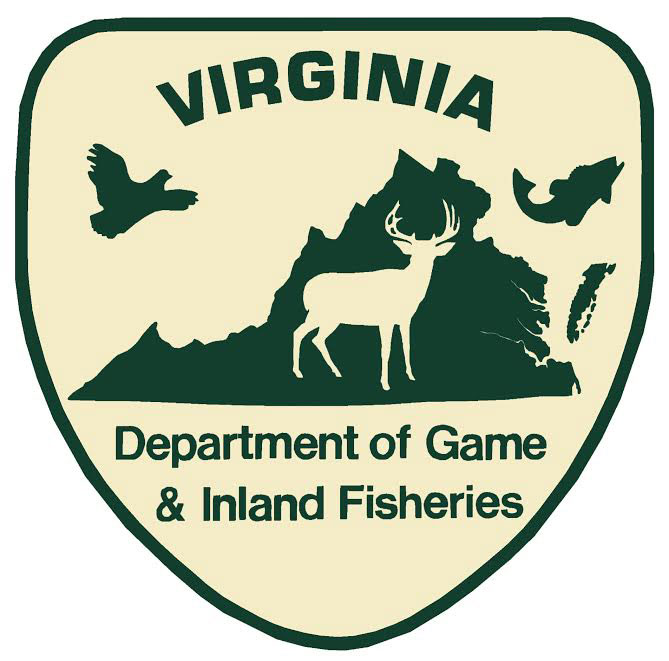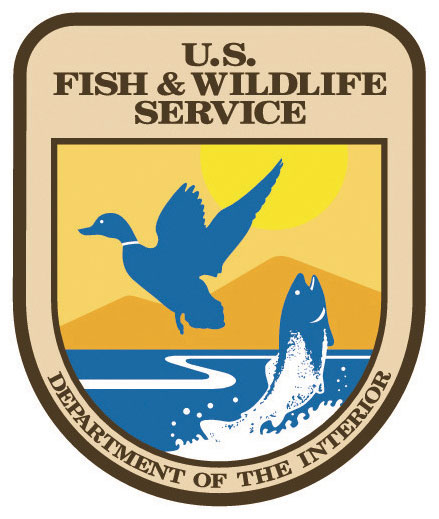Land Snail Ecology

Snail feeding tracks in algae on old RR car; by Ken Hotopp
Diet & Behavior
Eastern land snails will eat or at least taste many organic and even inorganic materials that they can crawl to or on. Eating and crawling, looking for food, are the primary activities during much of land snails’ active periods. Various aspects of diet and feeding behavior are discussed in great detail in Barker (2001).
Most land snail species are herbivorous or omnivorous, with only a few mainly predatory species. In snail diets, plants are the dominant food item, then fungi, animal matter and soil, though these preferences are deduced from studies of larger snails and slugs mostly from Europe (see Speiser 2001). Even within a species, snail diets vary widely, as animals take advantage of the foods that are available within crawling distance. Unlike most invertebrate herbivores that may be specialist feeders, including many insects, most land snails are generalists, sampling and assessing a large variety of food items in their path (see Speiser 2001).
Land snails are most often active at night and during damp weather because crawling requires mucus, which is mostly water, and humid air minimizes water evaporation. Once active, snails find food by using the chemoreceptors on their four tentacles, much as mammals use their nose. One Pennsylvanian species, the flamed disk (Anguispira alternata), learned to detour around a barrier to find food that it could smell (Atkinson, 2003).
If you watch some of the larger land snail species, as a snail is travelling it will often have its upper tentacles fully extended, sometimes waving, to sense chemical gradients in the air. When food is reached, the smaller lower tentacles become more active, often curved downward or touching the food item. The snail will also touch food with their mouth and foot, then begin rasping with the radula in its mouth (see Mackenstedt and Märkel, 2001).
The radula is a membrane covered with series of tiny teeth made of chitin, so it is coarse like sandpaper. The shapes of these small teeth are used to help identify some snail species. However, the teeth of the radula should not be confused with denticles in the aperture of a snail’s shell, which are often referred to as “teeth” as well.
The radula is drawn over a ridge of cartilage (the odontophore), somewhat like a chainsaw chain slides around its bar - though it moves back and forth rather than in a circular motion. Bits of food are broken off and drawn into the snail’s esophagus for digestion. Several bouts of crawling and feeding can occur during an outing.
If you allow a larger snail to crawl on your hand, you may be able to feel it “taste,” or rasp, your skin – the sensation is painless, but feels like a cat’s licking.
Saliva aids digestion in land snails, and muscular contractions move food along the esophagus as in people (see Dimitriadis, 2001). Digestive juices begin to break down food items here, and as they move into the gastric pouch. Connected to the gastric pouch is the large digestive gland that serves to absorb food, excrete waste, and regulate body chemistry.
From the gastric pouch, waste enters the intestine and rectum on its way back out of the body. Land snails excrete the undigested parts of their food from the anal pore, located in the mantle, at the edge of the shell in shelled species. Snail excrement may appear as a tiny folded rope. Microscopic examination of its contents can reveal what a snail has been eating, but most of what we know is from observed feeding behavior.
Land snails and slugs may eat herbaceous plant leaves or stems; rotting herbaceous plants, leaves, wood or bark, including the fungi that live within these items; fungal fruiting bodies such as mushrooms or conchs; and coatings of fungi or algae on rock or bark (e.g. Grime and Blythe, 1969; Mason, 1970; Hanley et al., 1995). Some snails such as the ambersnails (Succineidae) can be found in numbers upon lush floodplain herbs during June, while pinecone snails (Strobilops spp.) are found under the bark of a rotten log. Some herbivorous snails, especially introduced species, can be agricultural pests, which is why growers raising European snails for the escargot market usually have strict containment rules.
Snails and slugs are also found eating animal scats and carcasses; nematodes; old shells of other snails; or snail eggs, shells, and flesh. In the woods large snails such as the toothed globe (Mesodon zaletus) might be found upon white-tailed deer scats, while the gray-foot lancetooth (Haplotrema concavum) hunts and consumes live snails and slugs.
Organic and inorganic soil and rock particles are also ingested by snails. Consumption of calcium-bearing minerals provides the nutrient that snails need to build their shells, which are mostly calcium carbonate with a protein outer coating, the periostracum.
Land snails can ingest environmental contaminants and hold, or sequester, those contaminants in their tissues (e.g. Dallinger and Wieser, 1984), which makes snails useful indicators of pollution.
Snails that are tiny usually live very near or on their food – a drifted pile of leaf litter, or a rotten log. Others may move short distances from cover to food at night, which is often how slugs that feed in your garden escape detection. Snails are often found at the base of a plant or tree upon which they feed at night or in damp weather.
Large snails and slugs can make seasonal movements (e.g. Lloyd, 1967), perhaps traveling several meters to congregate on a rotten tree snag and then dispersing again. One eastern species, the broad-banded forestsnail (Allogona profunda) exhibited homing behavior in an Illinois study. It moved to a winter hibernation spot and returned in springtime to an area of fragmented log mould (Blinn, 1963).
In the field it is sometimes possible to see where snails have been feeding as indicated by slime trails, casts (snail excrement), and holes or feeding “tracks.” Squiggly lines or tiny fan patterns on rock or tree bark show where a snail has scraped off algae or fungi, leaving a paler spot. Smooth-barked red maple or American beech are good trees to check for snail or slug feeding tracks. You can look closely at mushrooms to see if a chewed area is found along with a slime trail.



Development of this site was supported by the generous contributions of Pennsylvanians to the Wild Resource Conservation Fund, and by the Virginia Dept. of Game and Inland Fisheries with a State Wildlife Grant from the US Fish & Wildlife Service.
